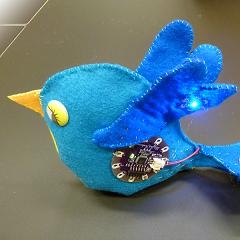Categories
- animatronics (12)
- apple (11)
- arduino (179)
- art (41)
- articles (121)
- artificial intelligence (11)
- automation (421)
- avr (205)
- bitcoin (3)
- breadboard (9)
- cameras (57)
- cars (26)
- cell phones (28)
- clothing mods (21)
- console mods (26)
- dangerous (94)
- desktop mods (24)
- embedded (5)
- flying things (54)
- fpga (22)
- gaming creations (108)
- interface (225)
- internet (17)
- laptop mods (6)
- lasers (22)
- linux (7)
- magnetic (3)
- medical (12)
- microcontrollers (51)
- misc projects (152)
- msp (12)
- music (124)
- pic (90)
- projects (23)
- pyroedu (76)
- raspberry pi (26)
- robots (312)
- security (36)
- sensors (307)
- software (200)
- solar (19)
- stamp (9)
- tools (149)
- tutorials (98)
- Uncategorized (45)
- usb (44)
- wireless (256)
Sponsors


Posted May 5, 2012 by Chris
“Although this kind of autonomous navigation has been accomplished in commercial products, the goal of this project is to make such a system work within a small vehicle, namely a model racing car. Considering the size of such a vehicle, two limitations come into effect: [1] Total mass of additional components and circuitry, [2] Driving range of car.”

Posted May 4, 2012 by Chris
“Squirt is an autonomous robot which can communicate with an Android phone. Optionally, the phone can be used as a controller to drive the robot. Squirt’s purpose is to water plants and chase away raccoons. It’s also a technology demonstration to prove the feasibility of using a smart phone to control small irrigation and well systems.”

Posted May 3, 2012 by Chris
“Another month purely devoted to robotics is upon us and we’re celebrating by releasing a 5 part, Building A Robot, series. This week we’re starting with the fundamentals, learning about DC motors and a Robot Chassis. Every week we’ll learn something new as we progress toward having a fully-functional robot.”

Posted April 27, 2012 by Chris
“The mobile robot RTT is a rover-type research prototype Rocker-Bogie suspension, six-wheel independent, grouped in two sets of three wheels on each side of the vehicle and secured by means of an articulated structure. The rear wheels are linked to the robot’s body by a rigid arm known as Rocker, and the same is fixed by means of a pivot, a second arm known as the bogie, which holds the middle and front wheels.”

Posted April 24, 2012 by Chris
“I built a wireless robotics platform from a cheap R/C car, an Arduino with XBee shield, small microswitch sensors, and a Processing program running on a remote computer to control the vehicle. The vehicle is completely controlled by the code running on the remote computer which allows very rapid prototyping of the code to tell the vehicle what to do and how to react to the sensor events received from the vehicle.”

Posted April 10, 2012 by Chris
“After some testing, I attached the WiShield WiFi module from Asynclabs, and then I started programming a socket application for the Arduino. I thought it would be fastest and easiest to use the TCP protocol directly, than serving a webpage. After some tests with Hercules SETUP Utility I made myself a controller application in Visual Basic .NET – and off we go!”

Posted April 8, 2012 by Chris
“Most of it is inside the AT90S2313 microcontroller. The black pipe makes Dizzy’s eye directional, so he can look for light and dark areas as well as motion – which he sees as rapid small changes in light level. The black paper hood does the same for his modulated IR receiver, allowing him to find his dining area.”

Posted March 26, 2012 by Chris
“The robot consists of nine cars connected with eight Futaba servos controlled by a microcontroller. All wheels are passive, the locomotion comes entirely from lateral undulation, which is wave movements in the plane similar to a snake. Continue reading for the story behind the project, how we fared at the RoboCup competition with videos, and for details about the electronic hardware, mechanical construction and software.”

Posted March 4, 2012 by Chris
“The Plushbot name illustrates the devices’ hybrid nature, which combines robotic parts like Arduino microcontrollers, conductive thread, a battery and various sensors with plush materials like stuffing and felt. The result: soft Plushbot toys that can be programmed to play music, change color (via LED lights) and move.”

Posted February 29, 2012 by Chris
“After struggling with what to do with poorly adjusted RC helicopter that had sat in my closet in the guest bedroom for over a year, this was the best idea that I came up with so far. This project really combined several concepts that I used in some other posts such as how easy small wooden boxes, like the one I used in the “even more useless machine” are to come across, and how a RC car can apparently be recycled for just about anything.”







